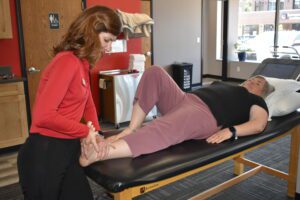Your ankle comprises three bones: the tibia, fibula, and talus. You might experience sudden ankle pain due to strains, sprains, or fractures when playing pickleball. The most common of these injuries is an ankle sprain, which happens when the ligaments (the tough bands that hold your bones together) get overstretched. This leads to swelling, inflammation, and pain.
Common Reasons for Ankle Sprains in Pickleball:
- Rapid direction changes during fast-paced rallies.
- Quick side-to-side movements and pivots.
- Slippery or poorly maintained courts, whether indoors or outside.
- Wearing shoes that don’t fit well or lack support.
If you’ve sprained your ankle before, you’re more likely to do it again because those ligaments may be weak or overstretched.
The Most Asked Questions About Ankle Injuries in Pickleball:
Q: What’s the difference between an ankle strain and an ankle sprain?
A: An ankle sprain affects the ligaments that connect and support the ankle joint, while an ankle strain involves the muscles or tendons around the ankle.
Q: What makes me more likely to get a sprain or strain while playing pickleball?
- Fatigue: As you get tired, your chances of getting hurt increase.
- Court Conditions: Slippery (indoors or outdoors) or uneven courts (outdoors) make injuries more likely.
- Footwear: Shoes that don’t fit well can lead to ankle injuries.
Q: How do you treat these injuries? Is it the same for both?
A: Yes! For both sprains and strains, you should follow the R.I.C.E. method in the first 24-48 hours:
- Rest: Don’t put weight on your ankle; use crutches if needed.
- Ice: Apply ice for 15-20 minutes every few hours to reduce swelling.
- Compression: Wrap your ankle with an elastic bandage to control swelling.
- Elevation: Keep your ankle raised, especially when you’re sleeping, to reduce swelling.
Q: When should I use heat instead of ice?
A: Heat is good for long-term injuries that have lasted more than a few weeks. Stick with ice for the first 48 hours after an injury.
Q: Can I prevent these injuries?
A: Yes! Regularly doing exercises that strengthen and stretch your ankle muscles will help prevent injuries. Stronger muscles mean better ankle support during play. Ask a physical therapist for guidance.
Q: What is an ankle fracture and how is it treated?
A: A fracture happens when one or more bones in your ankle break. This usually requires a cast or splint and avoiding any weight on your ankle for 4-8 weeks.
Q: How is an ankle injury diagnosed?
A: Your doctor or physical therapist will perform a physical exam to assess the severity of the issue. Imaging such as X-rays or an MRI may be ordered to see if there’s a fracture or ligament/tendon damage.
Q: When can I play pickleball again?
A: It depends on how serious your injury is. Your physical therapist will monitor your progress and give you the green light based on your pain level, swelling, strength, and mobility.
Q: Where can I get more info?
A: Your best bet is to see your doctor or physical therapist. They can diagnose your injury, give you treatment advice, and help you recover.
Injuries, like ankle sprains, are all too common on the pickleball court, but they don’t have to keep you sidelined for long. Partnering with a physical therapist is crucial for a full and swift recovery. They’ll not only help you heal but also equip you with the right techniques to prevent future injuries, keeping you at your best on the court. When it comes to staying in the game, having a physical therapist on your team is a smart move for any pickleball enthusiast.

